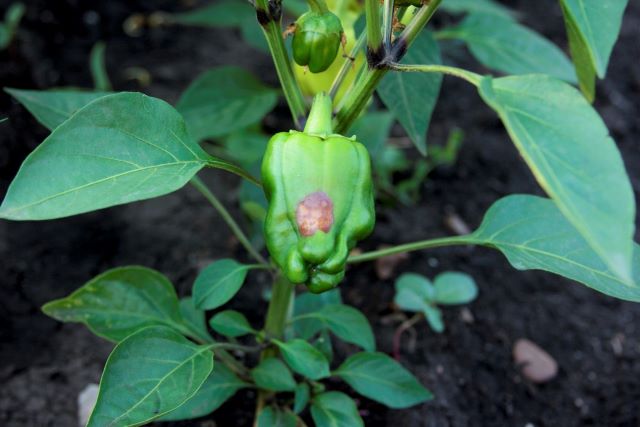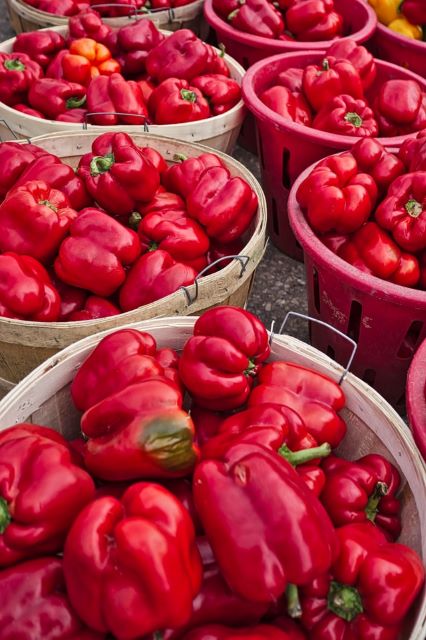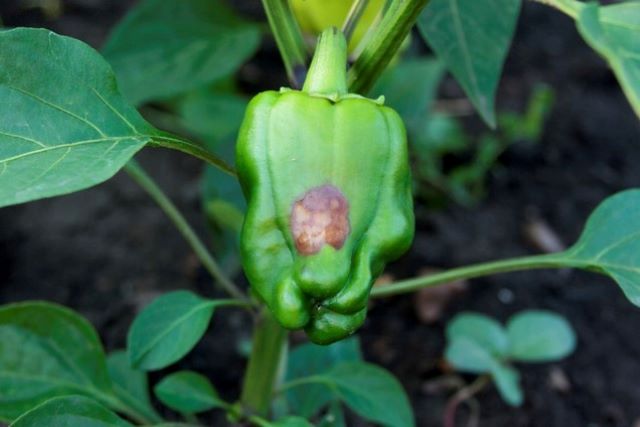Growing bell peppers in your garden can be very rewarding. The beautiful little jewels add flavor and color to a variety of delicious dishes. But growing your own peppers can be frustrating when they develop brown spots for apparently no reason at all. Here are some causes of brown spots on peppers and what you can do about them.

Brown spots on peppers can be caused by blossom end rot, restricted root growth, inconsistent watering, overwatering, over-fertilizing, sunscald and Anthracnose.
Let’s look into each one in more detail.
Related: 7 Bell Pepper Pests
Table of Contents
- Blossom End Rot Cause Brown Spots On Peppers
- Can You Eat Peppers with Blossom End Rot?
- Restricted Root Growth Causes Brown Spots On Peppers
- Inconsistent Watering Causes Brown Spots On Peppers
- Over Watering Causes Brown Spots On Peppers
- Over Fertilizing Peppers Causes Brown Spots
- Sunscald Causes Brown Spots On Peppers
- Can You Eat Peppers with Sunscald?
- Anthracnose Causes Brown Spots on Peppers
- Can I Eat Peppers that are Infected with Anthracnose?
- Summing Up
Blossom End Rot Cause Brown Spots On Peppers
Blossom end rot appears as brown marks near the bottom of the pepper (the end furthest from the stem where the blossom grew). The spots start out as light green or yellow and slowly turn brown over time. There are a variety of factors that can cause blossom end rot.
Causes of Blossom End Rot
Lack of calcium in the soil causes blossom end rot. This is probably the most common cause of blossom end rot. And will lead to brown spots on peppers.
Calcium helps to maintain the structure of cell walls in plants. It is therefore essential to the healthy development of roots, shoots, leaves, buds and fruit.
The skin of peppers, and other fruits and vegetables, need calcium to form correctly. If there is a lack of calcium the cell walls of skin cells will not form correctly, leaving spots of poorly formed skin. These spots will turn brown and may shrivel, causing the pepper to appear deformed.
Solution To Blossom End Rot
Add calcium to your soil – mix in crushed eggshells or bone meal. Both of these natural additives are high in calcium and will ensure your peppers develop sound skins.
Crushed eggshells can be added to the soil when planting but the calcium in this form is not easily absorbed by the plant. For best results, you can make a soluble eggshell fertilizer.
By adding a little white vinegar to the crushed eggshells the insoluble calcium carbonate in the eggshells is converted to soluble calcium.
Rinse the eggshells and then place them in the oven to dry on a low heat for 2 hours. This will dry them thoroughly and make sure any bacteria are killed.
Crush the eggshells as finely as you can. Use a rolling pin on a wooden board or a coffee grinder if you have one.
Measure your eggshell powder and add an equal amount of white vinegar. The mixture will bubble and froth. Allow it to settle for about an hour stirring periodically to ensure all eggshell powder has reacted with the vinegar.
Then use 4 tablespoons of eggshell mixture per gallon of water.
This fertilizer can be used on all your plants: flowering, fruit, vegetable and trees.
The use of milk, in any form: fresh, expired, powdered or evaporated, can also be added to the soil to increase the calcium content. To enable plants to absorb the calcium the milk should be diluted in equal parts with water.
Unfortunately, once the brown spots appear on the bell pepper due to blossom end rot there is no way of removing them. But you can make corrections to ensure peppers still developing do not get blossom end rot. You can also follow steps to ensure the problem does not occur the following season.
Can You Eat Peppers with Blossom End Rot?
Yes. You can definitely eat them. Simply cut away the brown spots and use the rest of the pepper. It is not a disease or fungus that may affect humans. It is merely a malformation of the skin due to a lack of calcium.
If the brown spots have black or white patches this is an indication that fungus or bacteria has taken advantage of the weakened skin. This should be carefully removed preventing contamination to the healthy part of the fruit. You can still eat the healthy parts of the pepper.
Restricted Root Growth Causes Brown Spots On Peppers
As calcium is absorbed through the pepper plant roots it follows that if the roots are not properly developed or fully functioning there will be a lack of calcium reaching the plant. This will lead to poor skin development and brown spots on peppers.
Solutions For Restricted Root Growth
Dig your soil over before planting to ensure the roots are able to grow through the soft soil. Additionally, allow enough space between plants so pepper plant roots are not overcrowded.
Inconsistent Watering Causes Brown Spots On Peppers
Peppers like to be watered regularly and consistently. Allowing the bell peppers to dry out and then become flooded will cause blossom end rot to set in.
Solution For Inconsistent Watering
Set up a watering schedule. Peppers need 2-4 inches of water per week. This should be spread evenly over the week rather than given all at once.
Over Watering Causes Brown Spots On Peppers
Over watering peppers also encourages blossom end rot to set in as the plant does not get a chance to dry off properly. Overwatering also interferes with the absorption of calcium as the calcium becomes too diluted in the water. This lack of calcium leads to blossom end rot.
Solution For Over Watering
Peppers only need 2-4 inches of water per week. Water the plants regularly and allow time for the soil to dry off a little between waterings. Mulching the bell pepper plants will help to keep moisture levels even and regular.
Over Fertilizing Peppers Causes Brown Spots
Nitrogen and potassium can hinder the absorption of calcium. Without sufficient calcium, peppers cannot form a healthy skin which leads to brown spots on the fruit.
Solution For Over Fertilizing Pepper Plants
Use nitrate-nitrogen rather than ammoniate nitrogen fertilizers. Be sure to follow the instructions so as to not over-fertilize.
Sunscald Causes Brown Spots On Peppers

Sunscald is another common cause of brown marks on bell peppers. This is basically like sunburn on the pepper.
It is caused by a combination of high temperatures and exposure to light. At first, the pepper fruit will develop a creamy brown mark (which is the sunburn). This weakened mark can then be an easy target for bacteria and fungus to set in.
Sunscald is easy to differentiate from blossom end rot as sunscald affects the leaves as well as the fruit while blossom end rot only affects the fruit.
Solution To Sunscald
Covering your pepper plants with shade cloth could help to protect them from the harsh sun and high temperatures. When choosing pepper plants look for a variety that has extensive foliage. These varieties offer shade to their fruit.
Adding Epsom salts to the water when watering young pepper plants, and other plants, helps the plants grow bushier. This will allow the plant to provide more shade for its fruit.
Add one tablespoon of Epsom salts to a gallon of water. Ensure that your soil contains enough calcium before feeding Epsom salts as Epsom salts will compete with the calcium for absorption.
Can You Eat Peppers with Sunscald?
Yes. You can eat peppers that have been damaged by sunscald. Sunscald is a sunburn of the fruit. It can be cut away and the rest of the pepper can be safely eaten.
Anthracnose Causes Brown Spots on Peppers

Anthracnose is a fungal infection more common in tomatoes and potatoes but can also attack peppers. It can be identified by its pattern of concentric rings which are sunken and can be anything from yellow-brown to black in color. A pinkish-orange tone to the lesions is an identifying characteristic of anthracnose.
Cause Of Anthracnose
Anthracnose is a fungus and often attacks fruit that has been left on the vine too long.
Solutions For Anthracnose
Remove pepper fruit from the vine as soon as it is ripe. This will help to prevent the fungus from setting in.
All infected peppers and leaves should be discarded rather than thrown on the compost heap. Infected plants will allow the fungus to breed in the compost heap and may cause further infection when compost is spread onto your vegetable garden the following season.
You can spray your pepper plant with an organic fungicide such as Actinovate, Serenade or copper to prevent anthracnose when you see the first signs of it on the fruit.
Regular crop rotation will also help to prevent anthracnose from attacking your pepper plants. Don’t plant peppers in the same place for more than 3 years. Yearly crop rotation is ideal.
Fruit nearest to the ground is most likely to be affected. This may be due to fungus spores in the soil. The transfer of these spores can be prevented by laying black plastic down before planting to form a barrier between the soil and the fruit.
If you are wanting to use seeds from your pepper crop for replanting next year and you have had anthracnose in your plants, you will need to treat the seeds before planting.
You can do this by soaking the seeds in hot water (51’C/125F) for 30 minutes. Overheating the seeds will render them infertile so caution is necessary.
Soaking the seeds in a weak bleach solution will kill any bacteria on the exterior of the seed but will have no effect on any internal bacteria. A weak bleach solution will have no negative effect on the fertility of the seed.
Can I Eat Peppers that are Infected with Anthracnose?
Yes, you can. If the infected area is small, you can simply cut the infected area away and eat the rest of the pepper fruit. If the infection is covering a considerable area of the pepper, it is better to throw the pepper away. Eating anthracnose fungus is not lethal but it can make one ill. Infected peppers should not be thrown onto the compost heap.
Summing Up
To prevent brown spots on your peppers, ensure your soil has enough calcium, water regularly and consistently, fertilize conservatively, shade your plants, harvest early and remove overripe fruit. Follow these guidelines and enjoy a thriving, healthy patch of peppers!
Further reading:
- Bell Pepper Flowers But No Fruit? Causes and Solutions
- Why Are My Bell Peppers So Small? Answered!
- Growing Jalapenos: Planting and Harvesting Jalapeno Peppers
- Bell Peppers Not Germinating? 6 Tips to Sprout Them
- Why Are My Chilies Not Ripening? Causes And Solutions
- 12 Zucchini Plant Diseases And How To Fix Them
- 5 Reasons Why Your Cucumbers Are Turning Yellow
- Brown Spots on Avocado Leaves: Causes and Solutions
- Spots on Arugula? Causes and Solutions
